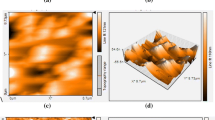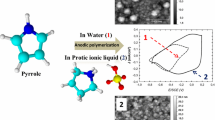Abstract
The present work has studied electrochemical and optical properties of poly(3,4-ethylenedioxythiophene):poly(styrenesulfonate) (PEDOT:PSS) film electrodes drop-casted from commercial PEDOT:PSS aqueous dispersion with preliminary addition and without addition of LiClO4 electrolyte (further denoted as PEDOT:PSS/LiClO4 and PEDOT:PSS). Cyclic voltammetry measurements showed the significant increase in capacitance of PEDOT:PSS/LiClO4 film electrodes in comparison to PEDOT:PSS. Furthermore, the improved charge transport in PEDOT:PSS/LiClO4 films was demonstrated by electrochemical impedance spectra. In situ spectroelectrochemical measurements revealed that preliminary addition of LiClO4 into PEDOT:PSS aqueous dispersion allows to increase amount of free charge carriers (polaron and bipolaron states) in the resulting film during electrochemical oxidation in LiClO4 propylene carbonate solution. This increase was attributed to ion-induced charge screening between positively charged PEDOT and negatively charged PSS in polyelectrolyte structure, which was supported by structural investigations of both types of film electrodes by using FTIR, SEM, and XPS measurements. Charge screening results from a more open structure that allows conformational relaxation of PEDOT molecules during charge transport, which leads to partial separation of oppositely charged PSS and PEDOT molecules and facilitating the increase of electrochemical activity.

ᅟ








Similar content being viewed by others

References
Groenendaal L, Jonas F, Freitag D, Pielartzik H, Reynolds JR (2000) Poly(3,4-ethylenedioxythiophene) and its derivatives: past, present, and future. Adv Mater 12:481–494
Sun K, Zhang S, Li P, Xia Y, Zhang X, Du D, Isikgor F, Ouyang J (2015) Review on application of PEDOTs and PEDOT:PSS in energy conversion and storage devices. J Mater Sci Mater Electron 26:4438–4462
Liu J, Agarwal M, Varahramyan K (2008) Glucose sensor based on organic thin film transistor using glucose oxidase and conducting polymer. Sensors Actuators B Chem 135:195–199
Nilsson D (2002) An all-organic sensor–transistor based on a novel electrochemical transducer concept printed electrochemical sensors on paper. Sensors Actuators B Chem 86:193–197
Wang GF, Tao XM, Wang RX (2008) Fabrication and characterization of OLEDs using PEDOT:PSS and MWCNT nanocomposites. Compos Sci Technol 68:2837–2841
De Kok MM, Buechel M, Vulto SIE, Van De Weyer P, Meulenkamp EA, De Winter SHPM, Mank AJG, Vorstenbosch HJM, Weijtens CHL, Van Elsbergen V (2004) Modification of PEDOT:PSS as hole injection layer in polymer LEDs. Phys Status Solidi Appl Res 201:1342–1359
Hong W, Xu Y, Lu G, Li C, Shi G (2008) Transparent graphene/PEDOT–PSS composite films as counter electrodes of dye-sensitized solar cells. Electrochem Commun 10:1555–1558
Krebs FC (2009) All solution roll-to-roll processed polymer solar cells free from indium-tin-oxide and vacuum coating steps. Org Electron 10:761–768
Shi H, Liu C, Jiang Q, Xu J (2015) Effective approaches to improve the electrical conductivity of PEDOT:PSS: a review. Adv Electron Mater 1:1–16
Ouyang J, Xu Q, Chu C-W, Yang Y, Li G, Shinar J (2004) On the mechanism of conductivity enhancement in poly(3,4-ethylenedioxythiophene):poly(styrene sulfonate) film through solvent treatment. Polymer (Guildf) 45:8443–8450
Xia Y, Ouyang J (2010) Anion effect on salt-induced conductivity enhancement of poly(3,4-ethylenedioxythiophene):poly(styrenesulfonate) films. Org Electron 11:1129–1135
Zhu Z, Song H, Xu J, Liu C, Jiang Q, Shi H (2015) Significant conductivity enhancement of PEDOT:PSS films treated with lithium salt solutions. J Mater Sci Mater Electron 26:429–434
Reyes-Reyes M, Cruz-Cruz I, López-Sandoval R (2010) Enhancement of the electrical conductivity in PEDOT: PSS films by the addition of dimethyl sulfate. J Phys Chem C 114:20220–20224
Xia Y, Ouyang J (2009) Salt-induced charge screening and significant conductivity enhancement of conducting poly(3,4-ethylenedioxythiophene): poly(styrenesulfonate). Macromolecules 42:4141–4147
Ouyang L, Musumeci C, Jafari MJ, Ederth T, Inganäs O (2015) Imaging the phase separation between PEDOT and polyelectrolytes during processing of highly conductive PEDOT:PSS films. ACS Appl Mater Interfaces 7:19764–19773
Kim G-H, Shao L, Zhang K, Pipe KP (2013) Engineered doping of organic semiconductors for enhanced thermoelectric efficiency. Nat Mater 12:719–723
Xia Y, Sun K, Ouyang J (2012) Solution-processed metallic conducting polymer films as transparent electrode of optoelectronic devices. Adv Mater 24:2436–2440
Xia Y, Zhang H, Ouyang J (2010) Highly conductive PEDOT:PSS films prepared through a treatment with zwitterions and their application in polymer photovoltaic cells. J Mater Chem 20:9740
Alemu D, Wei H-Y, Ho K-C, Chu C-W (2012) Highly conductive PEDOT:PSS electrode by simple film treatment with methanol for ITO-free polymer solar cells. Energy Environ Sci 5:9662–9671
Meana-Esteban B, Sundfors F, Espíndola P, Kvarnström C, Heinze J, Ivaska A (2008) Correlation between conductance and mass changes during p-doping of 2-methoxynaphthalene films. Electrochim Acta 53:7988–7994
Das PR, Komsiyska L, Osters O, Wittstock G (2015) PEDOT: PSS as a functional binder for cathodes in lithium ion batteries. J Electrochem Soc 162:A674–A678
Cíntora-Juárez D, Pérez-Vicente C, Kazim S, Ahmad S, Tirado JL (2015) Judicious design of lithium iron phosphate electrodes using poly(3,4-ethylenedioxythiophene) for high performance batteries. J Mater Chem A 3:14254–14262
Apraksin RV, Eliseeva SN, Tolstopjatova EG, Rumyantsev AM, Zhdanov VV, Kondratiev VV (2016) High-rate performance of LiFe 0.4 Mn 0.6 PO 4 cathode materials with poly(3,4-ethylenedioxythiopene):poly(styrene sulfonate)/carboxymethylcellulose. Mater Lett 176:248–252
Das PR, Komsiyska L, Osters O, Wittstock G (2015) Electrochemical stability of PEDOT:PSS as cathodic binder for Li-ion batteries. ECS Trans 68:45–58
Ghosh S (1999) Networks of electron-conducting polymer in matrices of ion-conducting polymers applications to fast electrodes. Electrochem Solid-State Lett 3:213–215
Ghosh S, Inganäs O (2001) Nano-structured conducting polymer network based on PEDOT-PSS. Synth Met 121:1321–1322
Chen Y, Zhang Y-H, Zhao L-J (2004) ATR-FTIR spectroscopic studies on aqueous LiClO 4, NaClO 4, and Mg(ClO 4 ) 2 solutions. Phys Chem Chem Phys 6:537–542
Greczynski G, Kugler T, Keil M, Osikowicz W, Fahlman M, Salaneck WR (2001) Photoelectron spectroscopy of thin films of PEDOT-PSS conjugated polymer blend: a mini-review and some new results. J Electron Spectros Relat Phenomena 121:1–17
Cruz-Cruz I, Reyes-Reyes M, Aguilar-Frutis M a, Rodriguez a G, López-Sandoval R (2010) Study of the effect of DMSO concentration on the thickness of the PSS insulating barrier in PEDOT:PSS thin films. Synth Met 160:1501–1506
Eliseeva SN, Spiridonova DV, Tolstopyatova EG, Kondratiev VV (2008) Redox capacitance of poly-3,4-ethylenedioxythiophene studied by cyclic voltammetry and faradaic impedance spectroscopy. Russ J Electrochem 44:894–900
Tolstopyatova EG, Pogulaichenko NA, Eliseeva SN, Kondratiev VV (2009) Spectroelectrochemical study of poly-3,4-ethylenedioxythiophene films in the presence of different supporting electrolytes. Russ J Electrochem 45:252–262
Gribkova OL, Iakobson OD, Nekrasov AA, Cabanova VA, Tverskoy VA, Tameev AR, Vannikov AV (2016) Ultraviolet-visible-near infrared and Raman spectroelectrochemistry of poly(3,4-ethylenedioxythiophene) complexes with sulfonated polyelectrolytes. The role of inter- and intra-molecular interactions in polyelectrolyte. Electrochim Acta 222:409–420
Nasybulin E, Wei S, Kymissis I, Levon K (2012) Effect of solubilizing agent on properties of poly(3,4-ethylenedioxythiophene) (PEDOT) electrodeposited from aqueous solution. Electrochim Acta 78:638–643
Pingree LSC, MacLeod BA, Ginger DS (2008) The changing face of PEDOT:PSS films: substrate, bias, and processing effects on vertical charge transport. J Phys Chem C 112:7922–7927
Acknowledgements
The authors would like to thank the SPbSU Resource Centre of Nanotechnology, the Resource Centre of Physical methods of surface investigations, and the Chemical Analysis and Materials Research Centre for providing common SEM, XPS, and FTIR analysis. The financial support from the Russian Foundation for Basic Research (grant no. 16-03-00457) is gratefully acknowledged. We thank Kseniia Vorobeva, Ekaterina Shkreba, and Mikhail Kamensky for the assistance in electrochemical experiment.
Author information
Authors and Affiliations
Corresponding author
Rights and permissions
About this article
Cite this article
Apraksin, R.V., Volkov, A.I., Eliseeva, S.N. et al. Influence of addition of lithium salt solution into PEDOT:PSS dispersion on the electrochemical and spectroscopic properties of film electrodes. J Solid State Electrochem 21, 3487–3494 (2017). https://doi.org/10.1007/s10008-017-3694-0
Received:
Revised:
Accepted:
Published:
Issue Date:
DOI: https://doi.org/10.1007/s10008-017-3694-0



